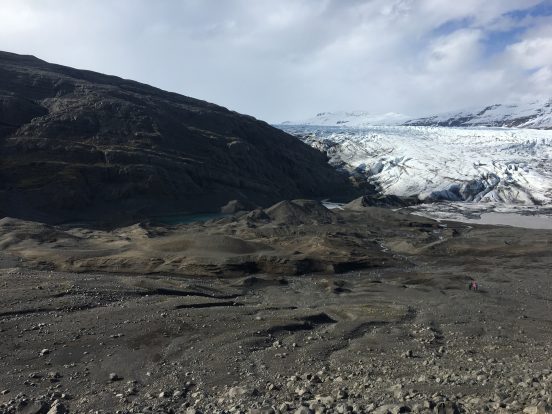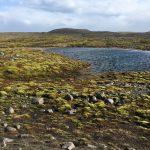Due to climate change, glacial retreat in Iceland is accelerating. Without proper action, the glaciers in Vatnajökull national park could entirely disappear within the next 150 to 200 years (Jònsson, 2017). Out of the small towns we visited, we’ve learned that Höfn is particularly vulnerable because of this change. It is located in Hornafjörður, a municipality in southeastern Iceland close to Vatnajökull National Park. From the increasing risk of landslide to the town’s infrastructure, glacial retreat is a big problem for this area. In this log entry, I will conduct a case study on the effects of glacial retreat in Höfn.
When Vatnajökull National Park was established in 2008, 40% of the municipality became protected area (2017). The municipality has 2200 inhabitants, with 1700 residing in Höfn. It is the third largest municipality in Iceland. The town had been isolated for a long time because the glacial rivers used to block all travel routes (2017). It has became a cultural and innovation hub in the recent years since the establishment of Nyheimer Knowledge Center and Vöruhúsið( The Warehouse). These two establishments provide a space for learning and artists to work. Aside from the intellectual exchanges in this town, they are also a leader in climate action for Iceland. In March 2016, they started a climate change project called Landvernd, which was a project from Denmark. They are committed to reduce GHG emissions by 3% annually (2017).
There are many changes to the geomorphology of Hornafjörður with glacial retreat. Firstly, Höfn falls in the tertiary basalt zone in rock formations (Hannessdóttir & others, 2013). This area is the most susceptible to rock falls and landslides because it is steeper. They can leave visible marks on mountain slopes with their sheer force. While there hasn’t been any imminent threat to Höfn, the future is unknown with the rate of glacial retreat. Vatnajökull is also home to many subglacial volcanos, such as Katla and Grímsvötn. With the landmass slowly decreasing, there is less pressure on top of the volcanoes and this could result in more volcanism in the region. This can trigger a series of jökulhlaups that will speed up glacial retreat. Moreover, the rivers will change their course rapidly, eventually disappearing all at once.
These geomorphological changes will disrupt the ecosystem as well. Since Höfn is the closest town to mainland Europe, the birdlife is quite abundant. They rely on the fish along the coast of the town. However, glacial melt is adding freshwater into the ocean, which decreases the temperature and salinity of the water. This will make the environment less suitable for fish, and the birds will have less to feed on. Meanwhile, the disappearance of rivers has already been affecting the local fishing industry (Jònsson, 2017). It is more difficult for fishermen to fish because the rivers are becoming more shallow.
From this case study, I’ve learned that glacial retreat is not only threatening the surrounding environment of Höfn, but also its economy. There are increase risks of glacial floods, volcanism and landslides. The fishing opportunities will decrease over time as the rivers change their course and disappear. In addition, Höfn has grown increasingly reliant on tourism, which owes to the beautiful landscapes around the town. If these landscapes disappear, less tourists will be attracted to visit Höfn. A positive takeaway from this study is that the town is united in climate action with their various projects. Hopefully in time, their efforts will pay off in raising awareness and protecting the wellbeing of their town.
Bibliography
Hannesdóttir, Hrafnhildur, Andreas Zöhrer, Helga Davids, Sigrún Inga Sigurgeirsdóttir, Hjördís Skírnisdóttir, and Þorvarður Árnason. Vatnajökull National Park: Geology and Geodynamics. PDF. Northern Environmental Education Development, 2013.
Ingólfsson, Ólafur, Hreggvidur Norddahl, and Haflidi Haflidason. “Rapid Isostatic Rebound in Southwestern Iceland at the End of the Last Glaciation.” Boreas24, no. 3 (September 1995): 245-59. doi:10.1111/j.1502-3885.1995.tb00777.x.
Jónsson, Björn Ingi. Sveitarfélagið Hornafjörður. PDF. Hornafjörður, May 29, 2017.
Magnúsdóttir, Rannveig. Climate Change and Hornafjörður Municipality. PPT. Balaton Lake, Hungary: Landvernd –IcelandicEnvironmentalAssociation, September 22, 2016.

